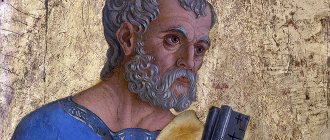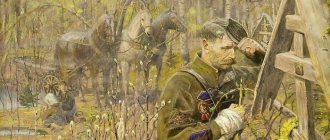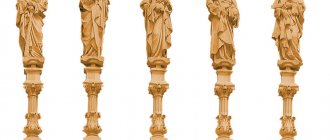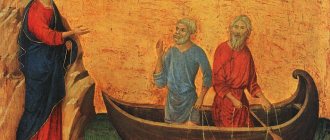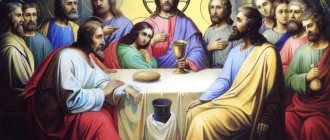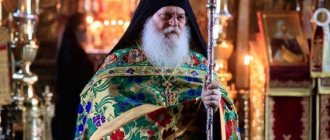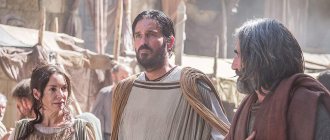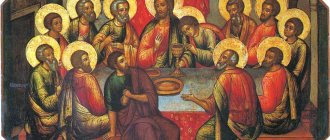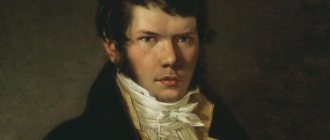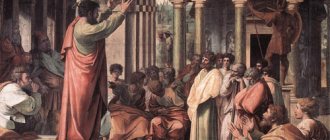“Apostles Peter and Paul” is an unusually restrained example of religious painting by El Greco. In contrast to the ecstatic, detail-rich multi-figure scenes (, ,), which made the painter famous both in his permanent habitat - Spanish Toledo - and far beyond its borders, this picture is extremely laconic, but no less effective. It is believed that the painting was originally intended for the altar of the Church of the College of Doña Maria de Aragon in Madrid. But as a result of hostilities in 1808, among other paintings by El Greco, the work was taken out of the city in order to prevent the plunder of the artist’s creative heritage by Napoleon’s soldiers. In 1911, Russian military leader Pyotr Durnovo donated the canvas with the apostles to the Hermitage, where it is kept to this day.
Peter and Paul: unity or struggle of opposites?
Despite the apparent simplicity of the composition, this painting by El Greco has become a fertile field for interpretation, on which venerable art critics have broken many copies.
Versions about what exactly the artist had in mind and what meaning he put into the gestures of the chief apostles were put forward the most contradictory, even the opposite. According to one of them, the canvas depicts an episode from the lives of the saints, described in the Epistle to the Galatians. In it, the Apostle Paul denounces his senior comrade-in-arms for hypocrisy and inconsistency, after he began to shun pagans in the presence of Jews who had accepted the Christian faith, while earlier he noted the need to carry out missionary work not only among Jews, but also other peoples.
From this point of view, the position of the Apostle Paul in the picture is interpreted as dominant, his gesture is accusing, and the Apostle Peter appears as a repentant apostate. But this concept has many opponents, and not without reason: the nature of the views of both saints does not correspond to it. They seem to be directed not from the outside, but inward, to contemplate something hidden from our eyes. It looks more like the preachers are deeply immersed in their prayers or serious spiritual thoughts.
Of course, the harmony of the composition is based on opposition, as is very often the case with El Greco. The experience and gray hair of St. Peter contrasts with the determination and steady gaze of his younger colleague. The artist’s favorite technique, in principle, was to play on contrast, especially between earthly and heavenly matters. And as El Greco usually preferred to do in such cases, he emphasizes it by combining various artistic means within one canvas.
The human nature of the apostles is reflected with the help of clearly, most realistically drawn faces, their hands, and background. And otherworldliness, participation in the Holy Spirit was embodied in shining capes, written in a free, expressive manner. The hierarchy of the apostles is conveyed using color: in Byzantine iconographic symbolism, golden is the highest color in the table of ranks, and red follows immediately after it.
"The Apostles Peter and Paul" by El Greco. Portrait of conflicting disciples or a bar for Christians?
Estimated reading time: less than a minute.
Historian, theologian, head of the Pilgrimage Center of the Apostle Thomas in Europe Timothy Katnis .
Timofey KITNIS
– “The Apostles Peter and Paul” is a very famous work by El Greco. But surely she wasn’t the most important thing in his life?
– The painting we are talking about dates back to the heyday of El Greco’s work in Spain. Of course, he had other very significant works, and quite a few. But in general, the theme of the apostles runs through his entire life, at the end of which he will write an entire apostolic cycle. He is now in Toledo. With such an appeal to Christ and the Church, he, as it were, draws a line to his artistic biography.
– By the way, about the biography. What is known about this person? Was his name really El Greco?
- No, it's a nickname. El Greco had a different name - Domenico Theotocopuli. He was born in Crete; the conventional date of birth is considered to be 1541. Conditional - because in 1601 he invited his friends to his 60th birthday. The time of his birth was calculated from this event, but it is hardly possible to verify this fact.
Crete at that time belonged to the Venetian Republic. Two communities coexisted there - Catholic and Orthodox. El Greco's parents were Catholics and raised him in their tradition. However, from an early age, as soon as he picked up a brush, he was under the special charm of the Cretan school of icon painting, which at that time - in the 16th century - was experiencing its heyday. His first teachers include the icon painter Michael Damaskinos; Theophanes of Crete had an indirect influence. Some researchers of El Greco's work are of the opinion that until the end of his life he remained faithful to the foundations that were laid in him in Crete. For example, he retained that special sense of light and space, the special symbolism that was in the iconographic art of that time. In addition, El Greco is characterized by the subtlety and precision of his faces, which also echoes the Cretan tradition.
However, he spent only part of his life in Crete. By the age of 26, El Greco felt the need to grow internally and professionally. To develop as a painter, he moved to Venice in 1567. Traces of his time there are obvious in his works: he studied in Titian’s workshop and at one time was deeply impressed by his work. Some art historians even believe that El Greco copied Titian. However, this is hardly fair. El Greco's talent is so original that if he ever copied anyone, it was only himself. Over time, he internally diverged from Titian. His aesthetics was still alien to El Greco, although he considered Titian a brilliant painter and a master of drawing. But El Greco himself was more inclined to deeper studies of human nature; Titian’s work seemed to him too sensual - more external than internal. El Greco was more ascetic in his works; he was interested primarily in the spiritual layer. In addition, Tintoretto had a huge influence on him during his stay in Venice. He took many techniques - the play of light and shadow, brush strokes, the theme and style of late mannerism - from this Italian artist. In general, it must be said that El Greco studied a lot, he was an extremely educated man of his time. He began his education in Crete, continued in Venice, and later moved to Rome.
– Why did he, a Greek, not paint icons, which seemed so characteristic of his homeland, but chose painting?
– In his work, as in life, El Greco strove for harmony. He grew up among Roman Catholics, and both iconography and Western painting were equally close to him. Plus, on top of everything else, he was a Renaissance man. As already mentioned, he studied all his life. He was fluent in four languages - Greek, Latin, Italian, and later Spanish. All his life he collected a library, which at one time was one of the most brilliant in Toledo, where he moved to permanent residence. It included 131 volumes of only the most valuable books in different languages, not counting other books. The main place there was occupied by the works of Renaissance figures. In other words, El Greco, of course, was impressed all his life by the Cretan school of icon painting, but this was not the only thing that influenced him. In art he followed his own original path.
And here one important detail should be noted: El Greco’s work is in many ways mysterious; in its style of writing it has no predecessors, although there are definitely traces of both Titian and Tintoretto there. He had no disciples left. In a sense, El Greco can be compared with Van Gogh - he was also absolutely original and only conditionally connected with his predecessors and contemporaries. As with Van Gogh, El Greco was misunderstood by many. For example, when he was already living in Toledo, an art critic, a man of very modern thinking, came to him. They, both men of the Renaissance, talked about art, philosophy, theology... And the guest was amazed at the unconventional thinking of El Greco, who first completely criticized Aristotle, and then generally stated that Michelangelo, of course, was a good man, but a bad painter. Of course, such a statement looked, to put it mildly, boldly; not everyone could understand it. By the way, El Greco later entered into competition with Michelangelo - when he wrote his famous work “The Opening of the Fifth Seal”. It has something in common with Michelangelo’s “Last Judgment” in the Sistine Chapel.
– When did El Greco begin work on Peter and Paul?
– In 1587 (and graduated in 1592). By this time, El Greco managed to live in Rome and move to Spain, to Toledo, which in a sense became his second homeland. However, it is still worth saying a few words about Rome. The city had a huge impact on El Greco. He walked past noble ruins, described, sketched, as expected, significant ancient objects... But he didn’t stay there for long - he didn’t really like the situation. Some researchers point out that El Greco was an oppositionist to the papacy, and Rome is the papal city. Be that as it may, from 1575 until the end of his days - until 1614 - he lived in Toledo.
– But why Toledo?
– This is still one of the most brilliant cities in Spain, but at that time... When the country was under the rule of the Moors, Toledo, in terms of the level of learning of its inhabitants, in terms of the level of philosophers who lived there, was a real competitor to the famous Cordoba Caliphate. Spain was finally liberated in 1492. However, traces of Moorish culture remained here for a long time. For example, when El Greco moved to Toledo, Arabic was still allowed there. True, seven years later - in 1582 - it was banned. But the master still found traces of the strong influence of Eastern culture. The situation in this city is well characterized by one episode. Once El Greco was summoned to appear before the Inquisition...
– For what?..
- No, nothing terrible happened to him, he was needed as a witness-translator. His fellow countryman, a man originally from Crete, a poorly educated peasant who was suspected of secretly practicing Islam, was subject to trial. El Greco served as an interpreter at the trial. The episode is very revealing: if the rejection of a foreign culture was so strong, it means that its pressure turned out to be very serious. It was at such a time that El Greco lived in Toledo.
– By the way, where did he live? Some patron?
- No, El Greco settled in a sense in a mystical house - in an estate that once belonged to the Marquis de Villena. He was considered almost a warlock. So El Greco lived in his house until the end of his days. There, in a workshop inside a luxurious mansion, where he received a narrow circle of like-minded people, he embodied the idea of the work we are talking about - “The Apostles Peter and Paul.” By this time, El Greco's work had reached its apogee. He is a mature artist and at the same time full of strength and energy.
– Why does he choose such a plot? Why doesn’t he write, for example, St. Andrew the First-Called or St. John the Theologian?
“He chose the subject not by chance. In both the Western and Eastern traditions, these two men are considered the founders of the Church. Of course, the true Founder is the Lord Jesus Christ, but the news of the Resurrection and the Church was carried by his apostles and closest disciples. With Peter the situation is clear: Christ Himself especially singles him out from among the other apostles. He says: Simon, you are Peter, that is, a stone, and on this stone I will build My Church. Even despite the mistakes that Peter makes in relation to Christ, when he denies Him on the night of His arrest, his seniority still returns to him. The Apostle John writes about this in the last chapter of his Gospel. The Lord asks Peter three times: Do you love Me? Peter answers in the affirmative three times. And the Lord says to him three times: Feed My sheep.
– What about Paul?
“His path to Christ was very unique. We see him first as a persecutor of Christians, he himself calls himself in one of his Epistles nothing less than a monster. We remember that Christianity, as soon as it began to spread, encountered sharp rejection both in the Jewish environment and then in the Roman one. Later Paul will write about this, that the Crucified Christ is a temptation for the Jews, and madness for the Greeks. He himself miraculously turns to Christ. This happened on the road to Damascus. Christ, completely unexpectedly for him, turns to him and meekly asks: Paul, why are you persecuting Me? - and Paul suddenly sees God Himself. This happened after the Ascension, after the Descent of the Holy Spirit on the apostles, who had already begun to preach. But despite the fact that Paul was called later than everyone else, he worked, perhaps, more than anyone else. It’s not for nothing that Nikolai Berdyaev calls him a religious genius. Only a religious genius is capable of completely changing his entire life for the sake of love for the Truth, breaking with everything that he previously worshiped. And this maximalist charge, ardent character traits - everything remains with Paul after his conversion until the end of his days.
Gradually, the environment to which he previously belonged breaks away from him, and he begins a very difficult path of the Gospel of Christ in every sense. It would be quite fair to say that he really worked harder than the other apostles. He left behind a colossal epistolary legacy - only a part of it has reached us, what we read in the New Testament. But if we compare the volume of works of the Apostle Paul and all other books within the New Testament, then his works will exceed all other books in volume. And when you read the book of the Acts of the Apostles, it is obvious that these are mainly the acts of Paul: he moves everywhere, founds communities everywhere.
Peter and Paul suffer martyrdom in Rome at about the same time. They both preach there, they are respected and loved by a huge number of people, but they are seriously bothered by many, because the influence of their preaching on people is extremely strong.
– Maybe it’s just me, but if you look at the picture, your attention is drawn to Pavel’s face. His figure seems to be highlighted, his hands are positioned as if inviting him to conversation. And Peter looks a little pitiful, guilty or something... Why?
– Perhaps because the figure of Pavel on the canvas really occupies more space, he has brighter clothes. Peter is, as it were, in the depths, and his face actually seems a little guilty. But this is only at first glance. To be fair, many art critics would agree with you. A very common point of view is that the painting depicts the moment of the dispute between Peter and Paul from the Epistle to the Galatians. Peter first agrees with Paul that it is necessary to convert uncircumcised pagans to Christ and not demand from them the fulfillment of the Mosaic Law. But when Jews came from Jerusalem who accepted Christ and continued to observe the Law of Moses, Peter began to eat and drink with the circumcised and shun the uncircumcised. The Apostle Paul denounced him: he said that Peter did this out of hypocrisy. Moreover, he accused him publicly and explained that by his actions Peter was discrediting the very idea of Christianity, which should be preached to the whole world, and not just to the Jews. The Apostle Peter sincerely repented and realized his guilt. Many believe that El Greco’s painting conveys precisely this moment of argument, exposure and repentance.
However, there is a wonderful work by the subtle art critic A. Vasilyeva, which challenges this idea. Indeed, if we look closely, we will see very interesting details in the picture. The Apostle Paul is not denouncing anyone here. If you look at his face, you can see that his lips are tightly compressed, his eyes look to the side, not at the viewer. The gaze is turned to another point or inside oneself. Actually, like the eyes of the Apostle Peter. He is older than Paul, in more faded clothes, his pose seems to internally testify - not about wine, but about the deepest prayer. If we pay attention to the hands of the apostles, then Paul leans on the book with one of them, and the other is turned towards the viewer. Peter's hands are at the same level. The position of their hands forms a kind of golden ratio; they are almost in the center of the picture. Peter holds the key in one hand - part of it is visible to the viewer, and the other hand is turned towards Paul. What does it mean? – It is important to remember here: despite the fact that we call Paul a religious genius, he nevertheless turned to Christ after the Resurrection. But Peter saw Christ almost from the first days of His preaching; he believed Christ even before the appearance of all His glory. And in fact, this position of the hands may indicate that Peter is sharing his prayerful, pastoral experience with Paul.
In general, even though the described conflict took place between Peter and Paul, they still treated each other with great brotherly love. Peter, for example, writes: listen to our beloved brother Paul, because he is filled with great wisdom. Yes, they had disagreements - the apostles are people too, but they always retained a sense of love and deep spiritual unity. Let me express my opinion - without, of course, pretending to comprehend God's providence, but still: I think it was not in vain that the Lord called Peter and Paul to martyrdom in the same period and in the same city where they preached at that time - in Rome. They also have the same day of church remembrance - July 12, according to the new style. With God nothing happens by chance. Such “coincidences” emphasize, it seems to me, the spiritual unity of the two apostles. Moreover, the fact that Peter and Paul are two very different not only in age, but also in human character is also obvious. El Greco shows this, for example, through the color of his clothes. El Greco generally believed that feelings can be conveyed not only through facial expressions, but also through color, light, details, and objects. The way we see the Apostle Paul speaks more about his character, and not about his superiority to his brother in Christ. The figure of Peter, in turn, is filled, on the one hand, with repentance, and on the other, with deep prayerful concentration. And this is also conveyed, including through clothing.
– What kind of book does Pavel have on hand? Does it also have some symbolic meaning?
– It is usually considered that this is the Gospel. However, if we look closely, we will see that he has two books at hand - one more thorough, the one below, and the second, lying on top, open, to which he directly points. It is quite possible that the Gospel is the book that lies at the foundation, the one on which the apostolic preaching is based. And it can be assumed that Paul points not directly to the Gospel text, but to the Apostolic Epistles, to letters. Personally, it seems to me that judging by the bookmark that we see in the open book, this is most likely the Epistle of the Apostle Peter. And the place that Paul himself points to, according to the logic of the picture, is his own text, where he himself writes about the ministry of the apostles. I think this may be the Epistle to the Ephesians: it has very strong similarities in spirit with the Epistle of the Apostle Peter. In my opinion, El Greco thus reveals the meaning and essence of the service of the Church, and not the conflict of the disciples of Christ. This fragment can be interpreted as harmony and internal unity in the service of the Church. Yes, everyone’s character and temperament are different, and service can be different. But its goal is one - preaching Christ, calling people into the fold of the Church. Thus, in the most important thing, the apostles are still united. And the author emphasizes this through various details, which is quite typical for Renaissance artists.
– There is such a point of view that the Apostle Paul in this canvas is very similar to the hero of another famous painting by El Greco - “Portrait of an Old Man”. It is considered a self-portrait of the master. And if so, then we can say that El Greco copied the Apostle Paul from himself. What do you think about it?
– There really is an external resemblance between the Apostle Paul and “Portrait of an Old Man”, and quite a lot. Although it is known that when El Greco wrote his apostolic cycle at the end of his life, he endowed the Evangelist Luke with his own traits. But as for Paul... This apostle, with his intellectualism, education, missionary approach, was always closer to the educated people of Toledo, the people of the Renaissance. By the way, this became another reason to talk about the opposition of the two apostles.
– Why?
– El Greco wrote “Peter and Paul” at a time when the institution of the papacy, the official Church, was subjected to serious criticism by a number of Renaissance figures. At the same time, Peter is clearly associated with the papacy, because he is the first bishop of Rome, and the chain of all pontiffs chronologically goes back to him. Thus, it can be assumed that the apostles are opposed to each other ideologically: one humbly accepts the established foundations, while the other thinks freely, outside of any framework or restrictions.
But if we look closely again, we will see a certain pillar in the background, as if it was even specially highlighted. He separates the two apostles. Of course, this is part of the interior of the room in which the apostles are, but... The fact is that El Greco has practically no random details, each has, in addition to factual, also symbolic meaning. There is every reason to believe that in fact this pillar is the foot of the Cross of Christ, at which Peter and Paul stand in silence and pray.
– Why do you think so? Where does such a bold assumption come from?
– It comes from the fact that in El Greco’s last work - in the cycle of the apostles - all the heroes also look in one direction, and Christ is the center of their attention. They are at the foot of the Cross. If we compare these works, it will be obvious: Peter and Paul are standing in the same place, at the Crucifixion. Their eyes are concentrated, their lips are closed, they pray. As Paul wrote: Remember, we are bought with a price. The apostles understand this very well. Hence their attention to the Cross. I think it is characteristic not only of the apostles, but of every Christian. And if not... Well, in this case, El Greco, through his “Peter and Paul,” sets each of us a high, but necessary bar.
Fishers of men
It is known from the Holy Scriptures that the chief apostles came to faith in radically different ways.
The fisherman Simon was called by Christ himself, giving him the name Peter. The cruel Pharisee Saul was brought down by the voice of God a year after the resurrection of Christ, when he was on his way to Damascus, being a persecutor of the first Christians. So he became the Apostle Paul, one of the most active preachers of Christianity. The artist draws attention to this difference in their destinies by placing two books in the lower right corner. The lower, larger one is obviously the Gospel on which Christian teaching is based. On top of it is the book of Acts, created by the apostles. It is not known whether this was El Greco's intention, but it turned out to be an interesting balance. The figure of the Apostle Peter takes up less space on the canvas, which is more than compensated by the presence at the forefront of a book that describes the most important events of his life - the years spent hand in hand with the Savior.
Paul, whose figure dominates the picture, confidently relies on the texts he created with his left hand (after all, it was he who wrote a significant part of the Apostolic Epistles), but with his right he seems to be accepting spiritual experience from the more sophisticated Peter. This intertwining of the hands and gestures of the two apostles is the semantic and compositional center of the picture, which is not coincidentally located exactly on the golden ratio. It is the interaction and mystical exchange of wisdom of such different but united missionaries, and not their opposition, that is the key idea of El Greco’s work.
Author: Natalya Azarenko
